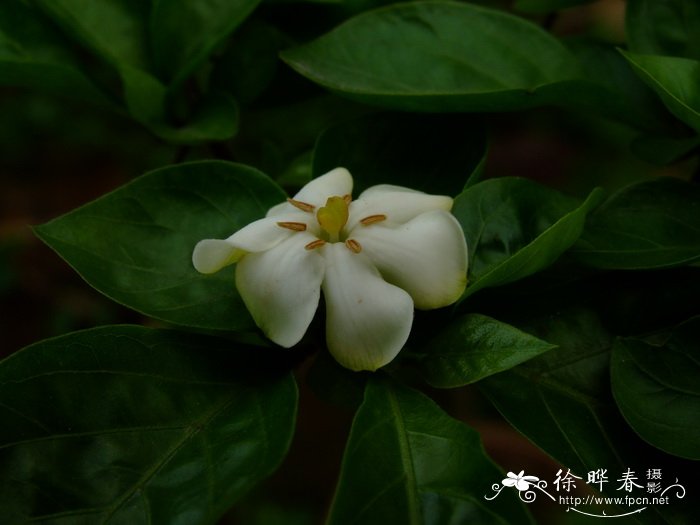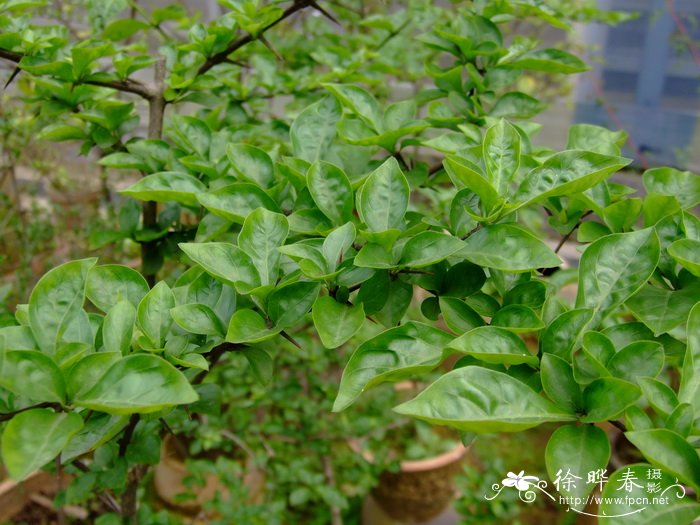山石榴Catunaregam spinosa
中文名(Chinese Name):山石榴
学名(Scientific Name):Catunaregam spinosa (Thunb.) Tirveng.
英文名(English Common Name):
别名(Chinese Common Name):牛头簕、刺榴
异名(Synonym):Gardenia dumetorum Retz. Randia dumetorum (Retz.) Lam. Xeromphis spinosa (Thunb.) Keay Xeromphis retzii Raf. Randia floribunda (Roxb.) DC. Randia oxypetala Lindl. Canthium coronatum Lam. Randia rottleri Wight & Arn. Randia lachnosiphonium Hochst. Solena dumetorum (Retz.) D.Dietr. Solena nutans D.Dietr. Solena longispina D.Dietr. Solena floribunda (Roxb.) D.Dietr. Posoqueria floribunda Roxb. Posoqueria dumetorum (Retz.) Willd. ex Roxb. Genipa dumetorum (Retz.) Baill. Gardenia floribunda Roxb. Gardenia stipularis Rottler Gardenia glabra R.Br. ex Wall. Gardenia dumosa Salisb. Narega coduva Raf. Canthium chinense Pers. Xeromphis obovata (Hochst.) Keay Randia brandisii Gamble Ceriscus malabaricus Gaertn.
科属(Family & Genus):茜草科(Rubiaceae)山石榴属
形态特征(Description):有刺灌木或小乔木,高1-10米,有时攀援状;多分枝,枝粗壮,嫩枝有时有疏毛;刺腋生,对生,粗壮,长1-5厘米。叶纸质或近革质,对生或簇生于抑发的侧生短枝上,倒卵形或长圆状倒卵形,少为卵形至匙形,长1.8-11.5厘米,宽1-5.7厘米,顶端钝或短尖,基部楔形或下延,两面无毛或有糙伏毛,或沿中脉和侧脉有疏硬毛,下面脉腋内常有短束毛,边缘常有短缘毛;侧脉纤细,4-7对,在下面稍凸起,在上面平;叶柄长2-8毫米,有疏柔毛或无毛;托叶膜质,卵形,顶端芒尖,长3-4毫米,脱落。花单生或2-3朵簇生于具叶、抑发的侧生短枝的顶部;花梗长2-5毫米,被棕褐色长柔毛;萼管钟形或卵形,长3.5-7毫米,宽4-5.5毫米,外面被棕褐色长柔毛,檐部稍扩大,顶端5裂,裂片广椭圆形,顶端尖,长5-8毫米,宽3-6毫米,具3脉,外面被棕褐色长柔毛,内面被短硬毛;花冠初时白色,后变为淡黄色,钟状,外面密被绢毛,冠管较阔,长约5毫米,喉部有疏长柔毛,花冠裂片5,卵形或卵状长圆形,长6-10毫米,宽约5.5毫米,广展,顶端圆;花药线状长圆形,伸出,长约3毫米;子房2室,每室有胚珠多颗,花柱长约4毫米,柱头纺锤形,顶端线2裂,长约2毫米。浆果大,球形,直径2-4厘米,无毛或有疏柔毛,顶冠以宿存的萼裂片,果皮常厚;种子多数。花期3-6月,果期5月至翌年1月。
分布(Distribution):产于台湾、广东、香港、澳门、广西、海南、云南,生于海拔30-1600米处的旷野、丘陵、山坡、山谷沟边的林中或灌丛中。东南亚、非洲东部热带地区也有。
用途(Use):木材致密坚硬,可作为农具、手杖及雕刻之用。根、叶作药用;根利尿、驳骨、祛风湿,治跌打腹痛;叶可止血。果亦作药用,在印度用作治疗脓肿、溃疡、肿瘤、皮肤病、痔疮、发疹、风湿、支气管炎等症。亦有栽植作绿篱。
引自中国植物志英文版:FOC Vol. 19 Page 85
Catunaregam spinosa (Thunberg) Tirvengadum, Bull. Mus. Natl. Hist. Nat., sér. 3, Bot. 35: 13. 1978.
山石榴 shan shi liu| Rubiaceae | Catunaregam
Gardenia spinosa Thunberg, Gardenia, 16. 1780; G. dumetorum Retzius; Randia dumetorum (Retzius) Lamarck; Randia spinosa (Thunberg) Poiret; Xeromphis retzii Rafinesque; X. spinosa (Thunberg) Keay.
Shrubs or small trees, 1-10 m tall; branches rather stout, hirsute, pilose, pilosulous, or puberulent to glabrescent, armed with axillary stout paired thorns 1-5 cm. Petiole 2-8 mm, pilose, pilosulous, or hirtellous to glabrous; leaf blade drying papery or subleathery, obovate or oblong-obovate or rarely ovate to spatulate, 1.8-11 × 1-5.7 cm, both surfaces glabrous to strigillose, strigose, hirtellous, or sparsely hirsute at least along principal veins, base cuneate and sometimes decurrent, margins entire or often shortly ciliate, apex acute; secondary veins 4-7 pairs, often with pilosulous domatia in abaxial axils; stipules caducous, ovate to broadly triangular, 3-4.5 mm, acute to aristate. Inflorescences terminal on lateral short shoots together with tufted leaves, 1-3-flowered; pedicels 2-5 mm, brown villous or -hirtellous. Calyx brown villous, -hirtellous, or -strigose; ovary portion ovoid to ellipsoid, 3.5-7 × 4-5.5 mm; limb slightly dilated, deeply lobed; lobes broadly elliptic to oblanceolate or obovoid, 5-8 × 3-6 mm, acute to rounded. Corolla white, becoming pale yellow with age, campanulate; tube 5-6 mm, sparsely villous in throat; lobes ovate or ovate-oblong, 6-11 × (5.5-)8-9 mm, spreading, rounded to subtruncate. Anthers ca. 3 mm, fully exserted. Style 4-6 mm; stigma fusiform, with 2 coherent lobes, ca. 2 mm. Berry globose, 2-4 cm in diam., glabrous or sparsely pilose or strigose; seeds 4-5 mm. Fl. Mar-Jun, fr. May-Jan.
Thickets or forests at streamsides, on hills or mountain slopes, or in valleys or fields; near sea level to 1600 m. Fujian, Guangdong, Guangxi, Hainan, Taiwan, Yunnan [Cambodia, India, Indonesia, Kashmir, Laos, Malaysia, Myanmar, Nepal, Pakistan, Sri Lanka, Thailand, Vietnam; Africa, Madagascar].
W. C. Chen (in FRPS 71(1): 338-340. 1999) noted that this species is sometimes climbing, but this has not been noted by any other authors nor seen on specimens.

 (责任编辑:徐晔春)
(责任编辑:徐晔春)
学名(Scientific Name):Catunaregam spinosa (Thunb.) Tirveng.
英文名(English Common Name):
别名(Chinese Common Name):牛头簕、刺榴
异名(Synonym):Gardenia dumetorum Retz. Randia dumetorum (Retz.) Lam. Xeromphis spinosa (Thunb.) Keay Xeromphis retzii Raf. Randia floribunda (Roxb.) DC. Randia oxypetala Lindl. Canthium coronatum Lam. Randia rottleri Wight & Arn. Randia lachnosiphonium Hochst. Solena dumetorum (Retz.) D.Dietr. Solena nutans D.Dietr. Solena longispina D.Dietr. Solena floribunda (Roxb.) D.Dietr. Posoqueria floribunda Roxb. Posoqueria dumetorum (Retz.) Willd. ex Roxb. Genipa dumetorum (Retz.) Baill. Gardenia floribunda Roxb. Gardenia stipularis Rottler Gardenia glabra R.Br. ex Wall. Gardenia dumosa Salisb. Narega coduva Raf. Canthium chinense Pers. Xeromphis obovata (Hochst.) Keay Randia brandisii Gamble Ceriscus malabaricus Gaertn.
科属(Family & Genus):茜草科(Rubiaceae)山石榴属
形态特征(Description):有刺灌木或小乔木,高1-10米,有时攀援状;多分枝,枝粗壮,嫩枝有时有疏毛;刺腋生,对生,粗壮,长1-5厘米。叶纸质或近革质,对生或簇生于抑发的侧生短枝上,倒卵形或长圆状倒卵形,少为卵形至匙形,长1.8-11.5厘米,宽1-5.7厘米,顶端钝或短尖,基部楔形或下延,两面无毛或有糙伏毛,或沿中脉和侧脉有疏硬毛,下面脉腋内常有短束毛,边缘常有短缘毛;侧脉纤细,4-7对,在下面稍凸起,在上面平;叶柄长2-8毫米,有疏柔毛或无毛;托叶膜质,卵形,顶端芒尖,长3-4毫米,脱落。花单生或2-3朵簇生于具叶、抑发的侧生短枝的顶部;花梗长2-5毫米,被棕褐色长柔毛;萼管钟形或卵形,长3.5-7毫米,宽4-5.5毫米,外面被棕褐色长柔毛,檐部稍扩大,顶端5裂,裂片广椭圆形,顶端尖,长5-8毫米,宽3-6毫米,具3脉,外面被棕褐色长柔毛,内面被短硬毛;花冠初时白色,后变为淡黄色,钟状,外面密被绢毛,冠管较阔,长约5毫米,喉部有疏长柔毛,花冠裂片5,卵形或卵状长圆形,长6-10毫米,宽约5.5毫米,广展,顶端圆;花药线状长圆形,伸出,长约3毫米;子房2室,每室有胚珠多颗,花柱长约4毫米,柱头纺锤形,顶端线2裂,长约2毫米。浆果大,球形,直径2-4厘米,无毛或有疏柔毛,顶冠以宿存的萼裂片,果皮常厚;种子多数。花期3-6月,果期5月至翌年1月。
分布(Distribution):产于台湾、广东、香港、澳门、广西、海南、云南,生于海拔30-1600米处的旷野、丘陵、山坡、山谷沟边的林中或灌丛中。东南亚、非洲东部热带地区也有。
用途(Use):木材致密坚硬,可作为农具、手杖及雕刻之用。根、叶作药用;根利尿、驳骨、祛风湿,治跌打腹痛;叶可止血。果亦作药用,在印度用作治疗脓肿、溃疡、肿瘤、皮肤病、痔疮、发疹、风湿、支气管炎等症。亦有栽植作绿篱。
引自中国植物志英文版:FOC Vol. 19 Page 85
Catunaregam spinosa (Thunberg) Tirvengadum, Bull. Mus. Natl. Hist. Nat., sér. 3, Bot. 35: 13. 1978.
山石榴 shan shi liu| Rubiaceae | Catunaregam
Gardenia spinosa Thunberg, Gardenia, 16. 1780; G. dumetorum Retzius; Randia dumetorum (Retzius) Lamarck; Randia spinosa (Thunberg) Poiret; Xeromphis retzii Rafinesque; X. spinosa (Thunberg) Keay.
Shrubs or small trees, 1-10 m tall; branches rather stout, hirsute, pilose, pilosulous, or puberulent to glabrescent, armed with axillary stout paired thorns 1-5 cm. Petiole 2-8 mm, pilose, pilosulous, or hirtellous to glabrous; leaf blade drying papery or subleathery, obovate or oblong-obovate or rarely ovate to spatulate, 1.8-11 × 1-5.7 cm, both surfaces glabrous to strigillose, strigose, hirtellous, or sparsely hirsute at least along principal veins, base cuneate and sometimes decurrent, margins entire or often shortly ciliate, apex acute; secondary veins 4-7 pairs, often with pilosulous domatia in abaxial axils; stipules caducous, ovate to broadly triangular, 3-4.5 mm, acute to aristate. Inflorescences terminal on lateral short shoots together with tufted leaves, 1-3-flowered; pedicels 2-5 mm, brown villous or -hirtellous. Calyx brown villous, -hirtellous, or -strigose; ovary portion ovoid to ellipsoid, 3.5-7 × 4-5.5 mm; limb slightly dilated, deeply lobed; lobes broadly elliptic to oblanceolate or obovoid, 5-8 × 3-6 mm, acute to rounded. Corolla white, becoming pale yellow with age, campanulate; tube 5-6 mm, sparsely villous in throat; lobes ovate or ovate-oblong, 6-11 × (5.5-)8-9 mm, spreading, rounded to subtruncate. Anthers ca. 3 mm, fully exserted. Style 4-6 mm; stigma fusiform, with 2 coherent lobes, ca. 2 mm. Berry globose, 2-4 cm in diam., glabrous or sparsely pilose or strigose; seeds 4-5 mm. Fl. Mar-Jun, fr. May-Jan.
Thickets or forests at streamsides, on hills or mountain slopes, or in valleys or fields; near sea level to 1600 m. Fujian, Guangdong, Guangxi, Hainan, Taiwan, Yunnan [Cambodia, India, Indonesia, Kashmir, Laos, Malaysia, Myanmar, Nepal, Pakistan, Sri Lanka, Thailand, Vietnam; Africa, Madagascar].
W. C. Chen (in FRPS 71(1): 338-340. 1999) noted that this species is sometimes climbing, but this has not been noted by any other authors nor seen on specimens.
踩一下[0]

顶一下[1]